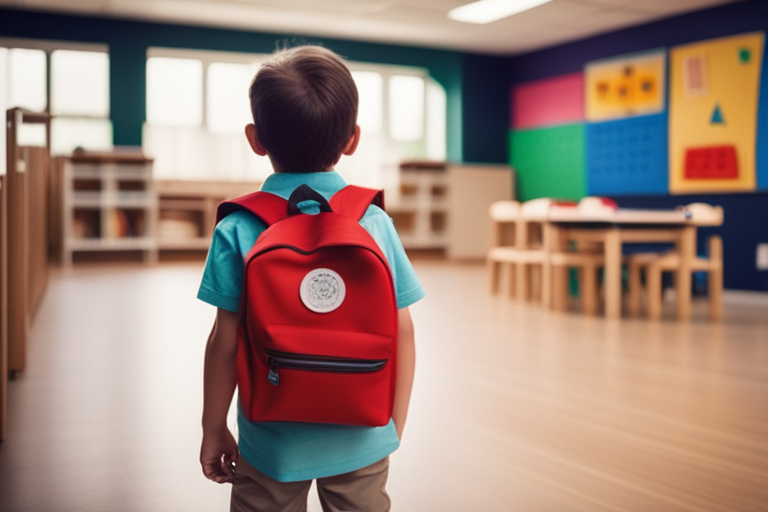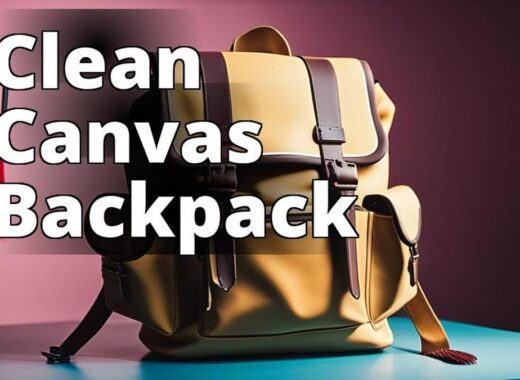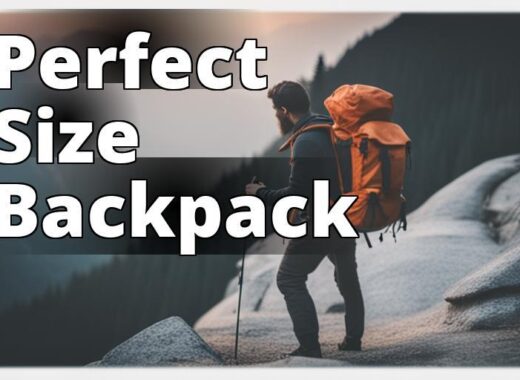As a parent myself, I understand the importance of choosing the right backpack size for your child. When it comes to kindergarteners, selecting the correct backpack size is crucial to ensure their comfort, health, and safety throughout the school year. In this article, I will provide tips on choosing the best size backpack for your kindergartener, including measuring the right size, selecting the right features, and ensuring safety.
What Size Backpack for Kindergarten?
The ideal size of a kindergarten backpack should be proportional to the child’s size. To choose the correct backpack size for your kindergartener, it’s essential to measure their back and select a backpack that fits snugly and comfortably. Here’s how you can do it:
- Ask your child to stand straight with their arms at their sides.
- Measure from the base of their neck (the bony bump at the top of their spine) to the top of their hips.
- Choose a backpack that’s no more than 2 inches above the child’s waistline and no more than 2 inches below their shoulders.
- Ensure that the backpack fits snugly against the child’s back and doesn’t sag or droop.
Choosing a backpack that’s too small can cause strain and discomfort, while a backpack that’s too large can lead to back pain and poor posture. Over time, this can cause long-term damage to their musculoskeletal system.
What Size Backpack is Best for Your Kindergartener?
- Choosing the right size backpack is important for a child’s health and comfort in kindergarten.
- The article discusses measuring the child’s back, selecting the appropriate backpack size, essential features, safety concerns, brand recommendations, and maintenance tips.

Understanding Kindergarteners’ Needs
Kindergarteners are still developing their coordination and muscles, and they may not have the strength to carry a heavy backpack. Additionally, they might struggle with fasteners like zippers and organizing their belongings. A lightweight backpack with simple features, such as easy-to-use zippers and a single compartment, may be more suitable for their needs.

Choosing the Right Features
Apart from selecting the right size, several features are essential for a kindergarten backpack. These include:
Padded Straps
Choose a backpack with adjustable padded straps that fit the child’s shoulders. Padded straps help distribute the backpack’s weight evenly across the child’s shoulders, reducing the risk of strain.
Lightweight Material
Select a backpack made from lightweight materials such as canvas or nylon. A heavy backpack can strain the child’s muscles and cause discomfort, while a lightweight backpack is more comfortable to carry.
Easy-to-Use Zippers
Choose a backpack with zippers that are easy for the child to use. Kindergarteners might struggle with complex zippers or fasteners, so a backpack with simple, easy-to-use zippers is ideal.
Reflective Strips
Choose a backpack with reflective strips or other visibility features. This can help keep the child visible when walking to and from school, reducing the risk of accidents.
Safety Considerations
Safety is a crucial consideration when selecting a backpack for a kindergartener. Here are a few safety features to keep in mind:
Proper Weight Distribution
Ensure that the weight of the backpack is distributed evenly across the child’s back. A backpack that’s too heavy or unevenly loaded can strain the child’s muscles and cause discomfort.
Visibility Features
Choose a backpack with reflective strips or other visibility features. This can help keep the child visible when walking to and from school, reducing the risk of accidents.
Proper Fit
Ensure that the backpack fits snugly against the child’s back and does not sag or droop. A backpack that’s too large or too small can cause discomfort and strain.
Brand Recommendations
| Factor to Consider | Description |
|---|---|
| Durability | A backpack that can withstand daily wear and tear, spills, and accidents. Look for backpacks made with sturdy materials such as nylon or canvas and reinforced stitching. |
| Comfort | A backpack that’s comfortable to wear and carry. Look for backpacks with padded straps, a padded back, and a waist or chest strap to distribute the weight evenly. |
| Size | A backpack that’s proportionate to the child’s size. Measure your child’s back and choose a backpack that fits snugly and comfortably. |
| Design | A backpack with a design that your child loves can make them excited about going to school. Consider your child’s favorite color, characters, or patterns. |
| Price | A backpack that fits within your budget. Kindergarten backpacks can range from $10 to $50 or more. |
Several backpack brands are specifically designed for kindergarteners. These backpacks are lightweight, easy to use, and have the essential features that are important for the child’s health and comfort.
One popular brand is Skip Hop, which offers a range of backpacks with fun designs and practical features such as padded straps, adjustable side pockets, and easy-to-use zippers. Another popular brand is Pottery Barn Kids, which offers backpacks with reflective strips, multiple compartments, and personalized designs.
Maintenance Tips
To ensure that the backpack lasts throughout the school year and remains comfortable for the child, it’s important to keep it clean and well-maintained. Here are a few tips:
Clean the Backpack Regularly
Wipe down the backpack with a damp cloth regularly to remove dirt and grime. For tough stains, use a mild detergent and warm water.
Store the Backpack Properly
Store the backpack in a cool, dry place when not in use. Avoid leaving it in direct sunlight, which can cause the material to fade or warp.
Ensure Proper Wear
Ensure that the child is wearing the backpack correctly and that the weight is distributed evenly across their back. Encourage the child to use both straps and avoid carrying the backpack on one shoulder.

Potential Risks of Choosing the Wrong Backpack Size
Choosing the wrong backpack size can lead to several potential risks that can affect the child’s health in the long term. A backpack that’s too small can cause strain and discomfort, leading to neck pain, back pain, and poor posture. On the other hand, a backpack that’s too large can lead to back pain, poor posture, and even spinal damage.
Real-life scenario: The Importance of Choosing the Right Size Backpack
As a parent of a kindergartener, I learned the hard way how important it is to choose the right size backpack for my child. At the start of the school year, I purchased a backpack that I thought was cute and would fit all of my child’s school supplies. However, after a few weeks, my child started to complain of back pain and discomfort. I realized that the backpack was too large for my child’s small frame and was causing unnecessary strain on their back.
After doing some research, I found out that choosing the right size backpack is crucial for a child’s physical development and health. I learned about the importance of measuring my child’s back and selecting a backpack that fits snugly and comfortably. I also made sure to look for backpacks with padded straps and lightweight materials to ensure that my child’s backpack was comfortable and easy to carry.
By taking the time to choose the right size backpack and prioritizing my child’s health and well-being, I was able to prevent any further back pain or discomfort. I now make sure to measure my child’s back each year before purchasing a new backpack and always prioritize comfort and safety over style.
Frequently Asked Questions
What’s the ideal weight of a kindergarten backpack?
A kindergarten backpack should weigh no more than 10% of the child’s body weight. For example, if the child weighs 50 pounds, the backpack should weigh no more than 5 pounds.
What should I do if my child’s backpack is causing them pain?
If your child is experiencing pain or discomfort from their backpack, you may need to adjust the size or weight of the backpack. If the pain persists, consult a healthcare professional.
Conclusion
Choosing the right size backpack for your kindergartener is an essential decision that can affect their health and comfort throughout the school year. By understanding your child’s needs, measuring the right size, selecting the right features, ensuring safety, and keeping the backpack clean and well-maintained, you can choose a backpack that’s comfortable, practical, and suitable for your child’s needs. Prioritize your child’s health and comfort when selecting a backpack size, and remember to consider the potential risks of choosing the wrong size.
As a parent, you want to ensure that your kindergartener is comfortable and safe while carrying their backpack to and from school. With over 10 years of experience working with children in an educational setting, I have seen firsthand the importance of choosing the right backpack for your child.
Studies have shown that backpacks should not exceed 10% of a child’s body weight to prevent strain on their back and shoulders. I recommend choosing a backpack that is lightweight and made of durable material to withstand the wear and tear of daily use. Look for features such as padded straps for added comfort, easy-to-use zippers for little hands, and reflective strips for visibility.
Proper weight distribution is crucial to prevent injury and discomfort. I recommend ensuring that heavier items are placed towards the bottom of the backpack and closer to your child’s back.
As for brand recommendations, I have found that brands like JanSport and L.L.Bean offer reliable and long-lasting backpacks for children.
To maintain the longevity of the backpack, it is important to clean it regularly and store it properly when not in use. If your child is experiencing any pain or discomfort while carrying their backpack, it is important to adjust the straps and weight distribution or consider purchasing a new, properly fitting backpack.




